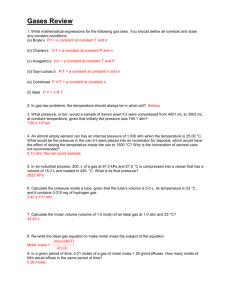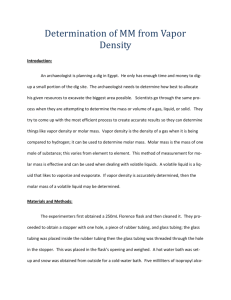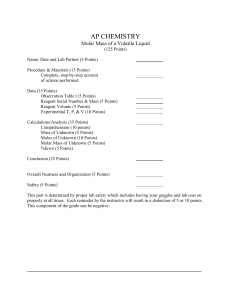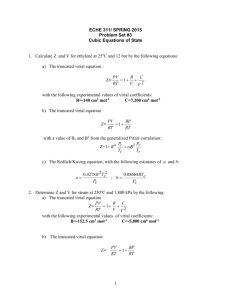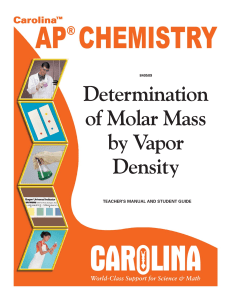Experiment Four: Determination of Molar Mass of A Volatile Liquid
advertisement
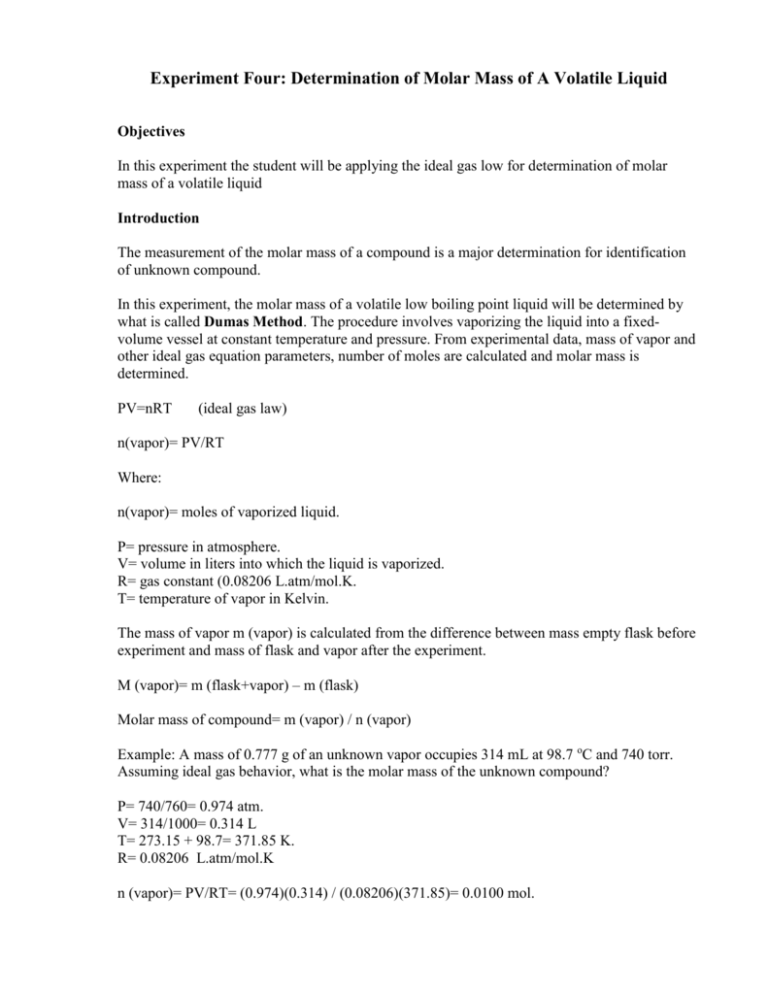
Experiment Four: Determination of Molar Mass of A Volatile Liquid Objectives In this experiment the student will be applying the ideal gas low for determination of molar mass of a volatile liquid Introduction The measurement of the molar mass of a compound is a major determination for identification of unknown compound. In this experiment, the molar mass of a volatile low boiling point liquid will be determined by what is called Dumas Method. The procedure involves vaporizing the liquid into a fixedvolume vessel at constant temperature and pressure. From experimental data, mass of vapor and other ideal gas equation parameters, number of moles are calculated and molar mass is determined. PV=nRT (ideal gas law) n(vapor)= PV/RT Where: n(vapor)= moles of vaporized liquid. P= pressure in atmosphere. V= volume in liters into which the liquid is vaporized. R= gas constant (0.08206 L.atm/mol.K. T= temperature of vapor in Kelvin. The mass of vapor m (vapor) is calculated from the difference between mass empty flask before experiment and mass of flask and vapor after the experiment. M (vapor)= m (flask+vapor) – m (flask) Molar mass of compound= m (vapor) / n (vapor) Example: A mass of 0.777 g of an unknown vapor occupies 314 mL at 98.7 oC and 740 torr. Assuming ideal gas behavior, what is the molar mass of the unknown compound? P= 740/760= 0.974 atm. V= 314/1000= 0.314 L T= 273.15 + 98.7= 371.85 K. R= 0.08206 L.atm/mol.K n (vapor)= PV/RT= (0.974)(0.314) / (0.08206)(371.85)= 0.0100 mol. Molar mass= 0.777/0.0100= 77.5 g/mol. Experimental You are to perform two trials. Obtain 15 mL of unknown liquid from your instructor and make sure that you use the same flask for both trials. 1. Weigh to nearest 0.01 g a clean dry 125 mL Erlenmeyer flask and a one-hole stopper. 2. Add about 6 mL of the liquid to the flask and insert the stopper. 3. Cover the stopper with a small piece of aluminum foil and secure with a rubber band. 4. Using a pin, pierce the aluminum foil several times at the point where the foil covers the hole in the rubber stopper. 5. Fill a 600 mL beaker half-way with water and support it on wire gauze and bring to boil using Bunsen burner. 6. Remove the burner and lower the Erlenmeyer flask in the water bath. Make sure that neither the flask nor the clamp touches the beaker wall, and that the water level is high on the neck of the flask. 7. Resume heating until the water boils. 8. When the liquid in the flask or vapor from the holes in the aluminum fil are no longer visible, continue heating for another 5 minutes. Record the temperature (± 0.1 oC) of the boiling water. 9. Remove the flask and allow cooling to room temperature and drying the outside of the flask, then weigh it. Don’t forget to remove aluminum foil before weighing. 10. Repeat the procedure for trial 2. 11. To determine the volume of the vapor, fill the empty Erlenmeyer flask to the rim with water and insert the one-hole stopper. 12. Remove the stopper and measure the volume ((± 0.1 mL) of the flask by transferring the water to a 100 mL graduated cylinder. Record the volume. 13. Record the atmospheric pressure in the lab by reading the barometer. Experiment Four: Determination of Molar Mass of A Volatile Liquid Pre-Laboratory Report Student name: Section: ID: Instructor: 1. A mass of 0.877 g of an unknown vapor occupies 354 mL at 99.7 oC and 720 torr. Assuming ideal gas behavior. a. How many moles of vapor are present? b. What is the molar mass of the vapor? c. If the atmospheric pressure is mistakenly recorded as 760 torr. What will be the reported molar mass of the vapor? d. What is the percent error caused by the mistaken reading in c? ( % Error= [(molar mass in c – molar mass in b) / molar mass in b] X 100 Experiment Four: Determination of Molar Mass of A Volatile Liquid Results and Calculations Student name: Section: ID: Instructor: Unknown number Trial 1 Mass of dry flask and stopper (g) Temperature of boiling water (K) Mass of dry flask, stopper and vapor (g) Volume of 125-mL flask (L) Atmospheric Pressure (atm) Moles of vapor, n (vapor) Mass of vapor, m (vapor) (g) Molar mass of unknown liquid (g/mol) Average molar mass (g/mol) Trial 2 Calculations: Conclusions:

